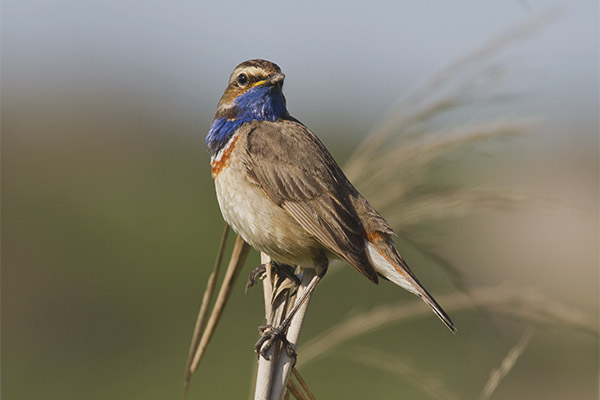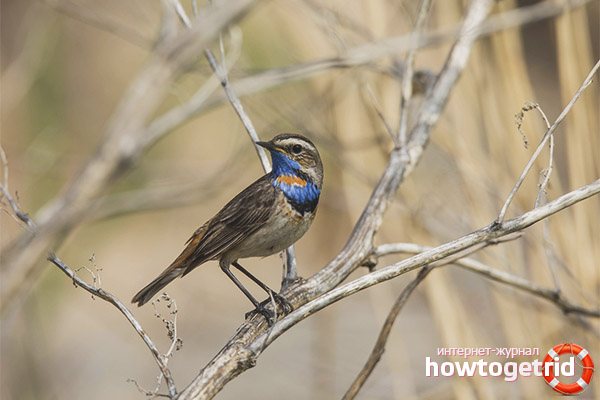The content of the article
One of the most beautiful birds, which is found in central Russia and South Asia. Its plumage cannot be confused with other species of birds.
External description of the bird
It is small in size, its length does not exceed 15 centimeters, and its wings are 7-8 centimeters. At such modest size, it has a rather bright coloring in the area of the breast. The plumage in this part of her body has a blue color. Along the edges of this bright spot is a border of black and red color. The tail also has a red color with a black stripe on the end. But the color of the female is different from the males. The blue color in her plumage is missing. Instead, it has a brown and whitish hue. Females do not need to attract excessive attention to themselves, because they are mainly engaged in the incubation of offspring. And among the bushes and grass gray color is not noticeable.
Habitat
The bird belongs to the migratory species. Therefore, her melodic singing can be heard no earlier than April. It is at this time that she arrives from the warm countries of Africa or Asia. Varakushka nests in the grass. Nests viet from stalks, obkladyvaya their moss. In such homes, she breeds. With the onset of cold weather flies into a warmer climate for the winter.
The way of flying birds is very interesting. It does not rise high in the sky, but moves through shrubs along the water bodies. Thus, it can cover about 100 kilometers per night.
What to eat
The main food for this bird are various insects. She eats midges, ants, dragonflies, beetles and their larvae. But not only insects determine its diet. She is not averse to eat ripe berries and seeds, especially in the autumn period. Varakushka is considered an orderly of the forest due to the fact that it feeds on harmful insects.Therefore, gardeners are not averse to attracting it to their plots. It cleans plants from slugs and other harmful animals.
This bird is protected by humans. For this reason, it was even made a 2012 bird.
In the suburban villages rarely breeds. This is due to the fact that land predators, such as cats, often ruin their nests. Therefore, in the vicinity of cottages birds are afraid to make their nests.
How varakushka reproduces
This bird is distinguished by its isolation. They usually do not flock, and live alone. More value family nest and one partner. With him, they can live a lifetime. In the spring, the males arrive from the south. At this time, their marriage games begin. Males lure females with their bright plumage. At this time they have it especially pronounced. Attracting the females with their melodious singing, they suggest starting the nest with one of them.
The formed pair begins to create a family nest. It is shaped like a bowl lined with moss on the outside. The inside of the nest is filled with down and soft grass. It is noteworthy that, having built a nest, they return to it next spring.The fact that it is occupied, the male informs everyone around with his loud singing.
In it, the female lays 5-7 eggs. The incubation period lasts about 2 weeks. After passing this time, the chicks are born. For 13 days they remain in the nest, and their parents feed them hard. The father carefully brings the caterpillars and insect larvae.
After the chicks are stronger, they begin to jump out of the nest. At the same time, they do not have flight skills yet. They are jumping on the ground, not far from the former dwelling. In the process of communicating with their parents, they learn to fly and get their own food.
At the end of the summer, the birds fly south, but without a flock. These birds go there on their own, and not in a group. Departure ends by September or October, depending on the region of habitat.
Types of bode
There are only two species of this bird - the Red Star and the White Star. They are distinguished by a characteristic spot on the chest in the form of a star. The red star looks different less melodic singing. The repertoire of the bird includes mostly overheard melodies.
Another species is distinguished by its large size and characteristic singing, which is more melodic and diverse. Includes rustling and whistling sounds. By its sound, the singing of these birds is very close to the nightingale trills.But while they can not take such high notes like a nightingale.
Interesting facts about the bird
- Moving to wintering in warm countries, birds change plumage. There it becomes dimmer and faded. With the onset of spring plumage gets brighter shades. So they come to their homeland in all its glory.
- When meeting a man, the bird turns his back to him. And since in nature it can be seen too rarely because of the places of its settlement, it merges with the surrounding thickets. It has a gray color on the back, which securely disguises it among the grass. Relying on it, the bird believes that it becomes invisible to humans.
- The bird was called the “patriot of Russia” because of its coloring on the chest. The combination of colors of the Russian flag on her body allowed her to get such a nickname.
- The ability of birds to imitate the voices of other members of the family of birds allows them to eliminate competitors. Adjusting to other birds, they provide them with false information. So they free the territory for themselves.
Varakushka Guard
Unfortunately, the population of this bird has been declining recently. This is due to the fact that people are setting fire to old grass.Or abandoned bonfires left cause fire. Varakushka builds its nests in the grass, almost near the ground. Therefore, nests are often burned in such fires along with eggs or even chicks. Environmentalists warn that the consequence of these actions of a person can be the complete loss of Varakushka songbird, who sings so melodiously all summer.
Video: Warakushka (Luscinia svecica)













To send